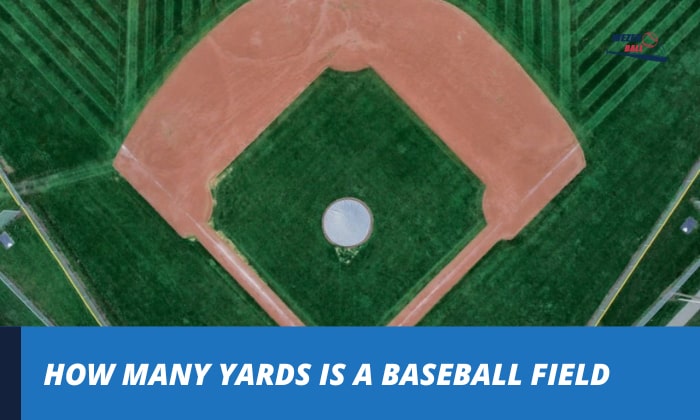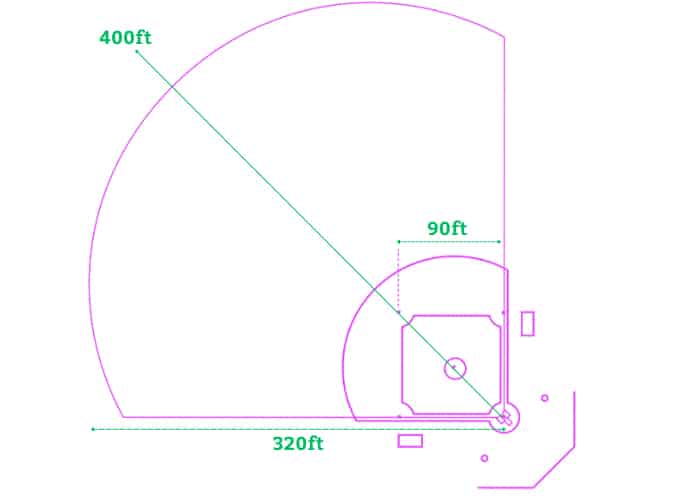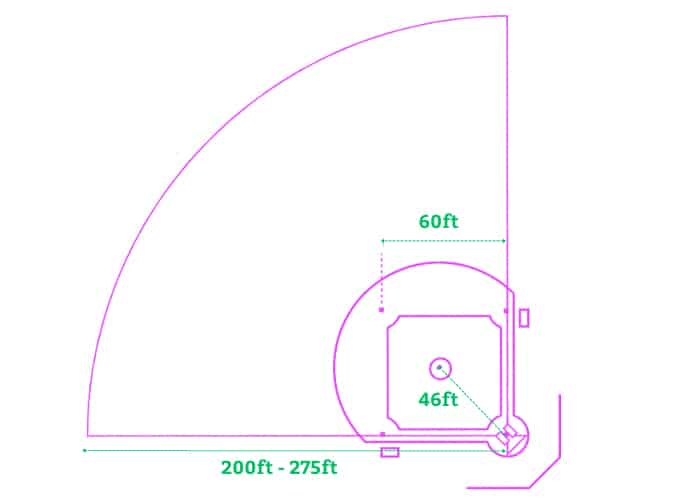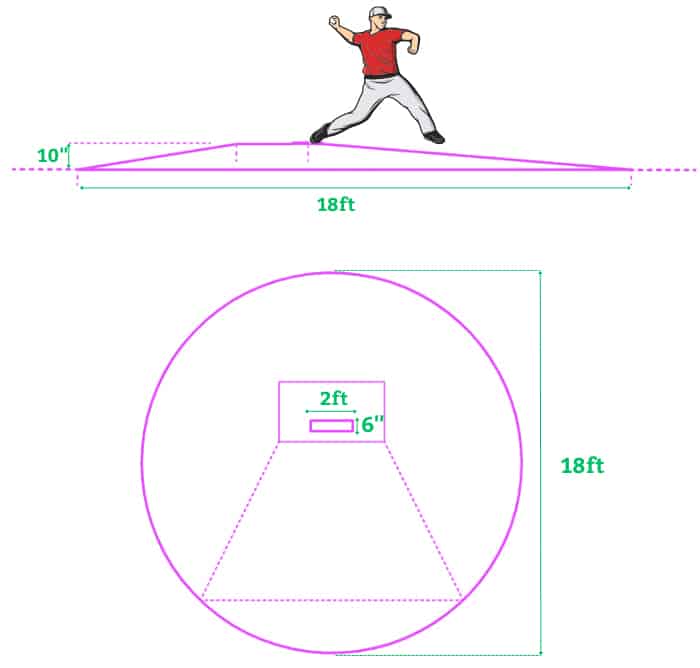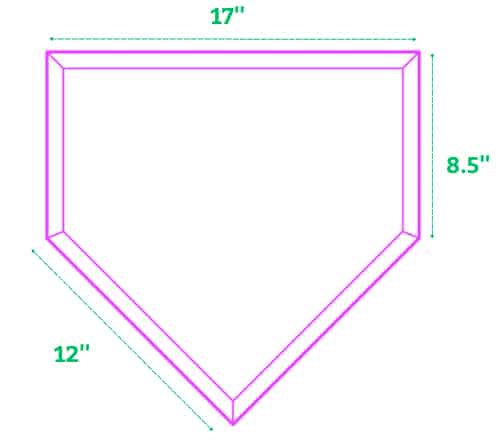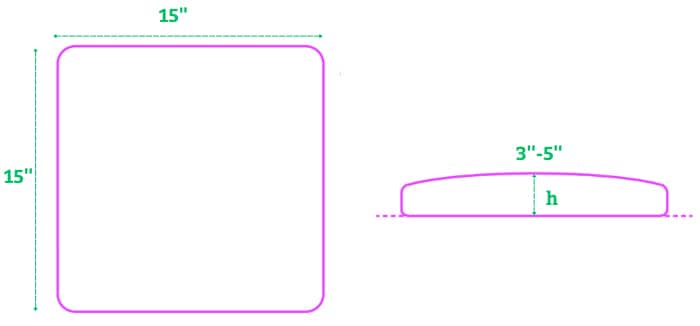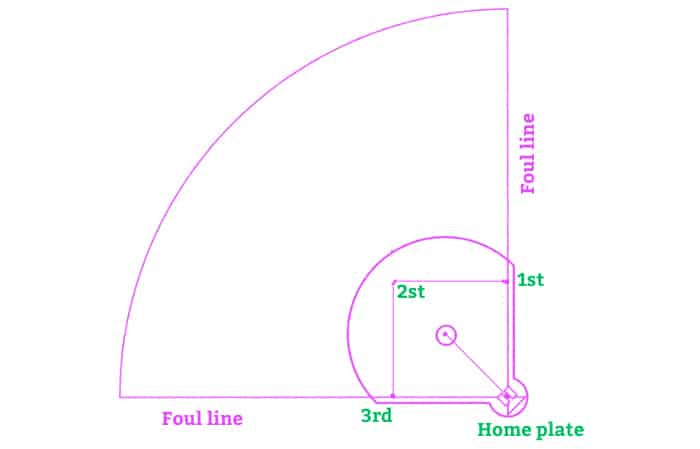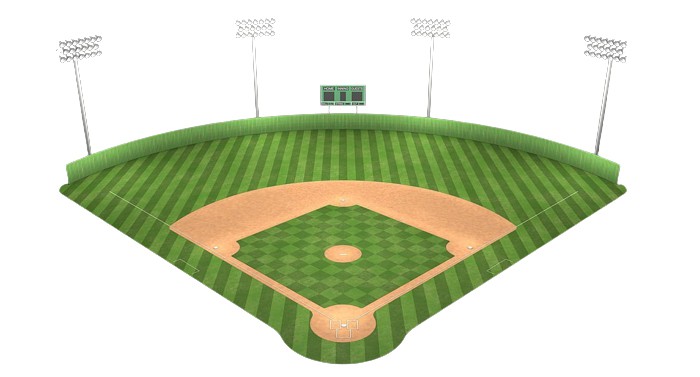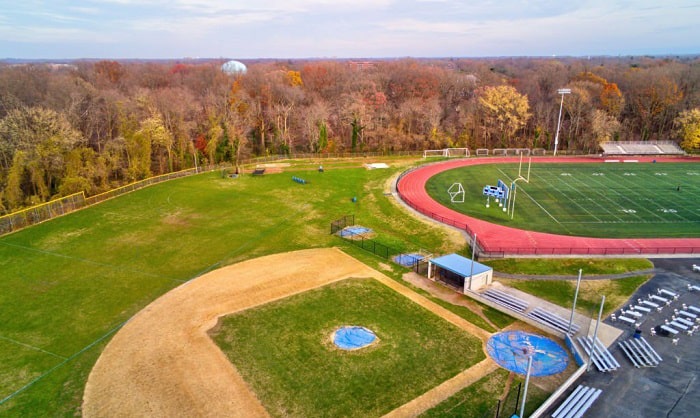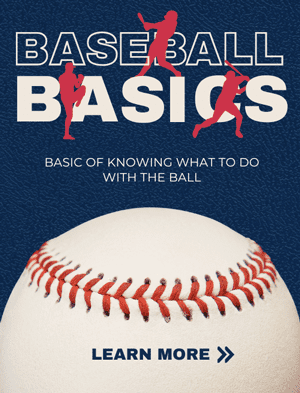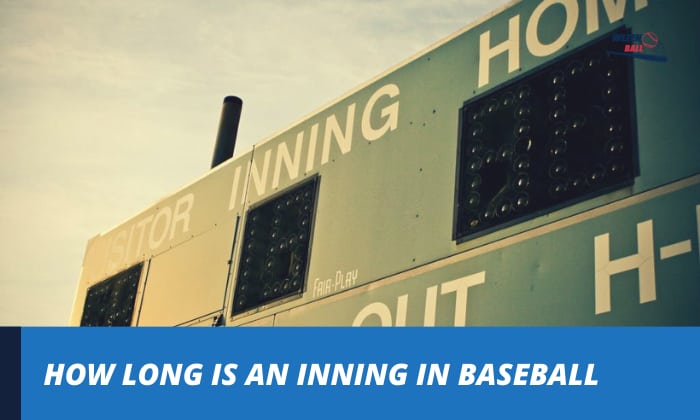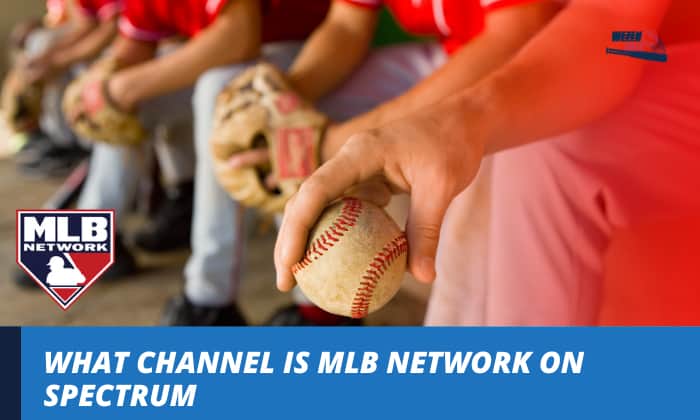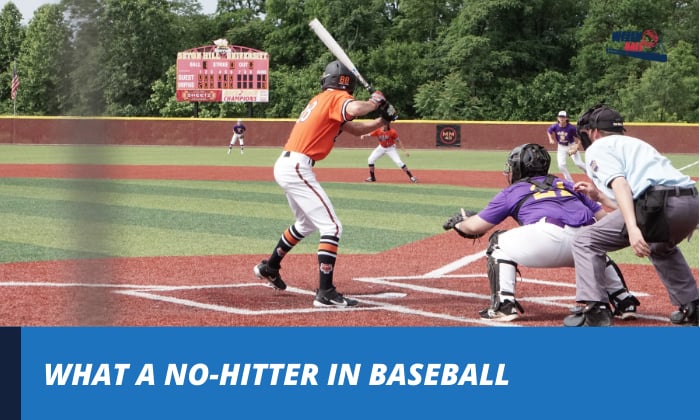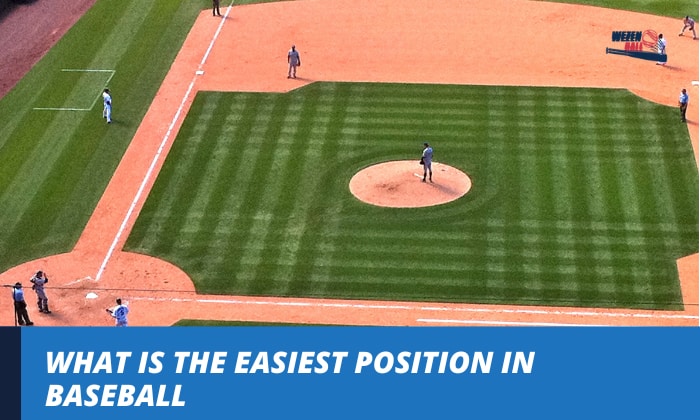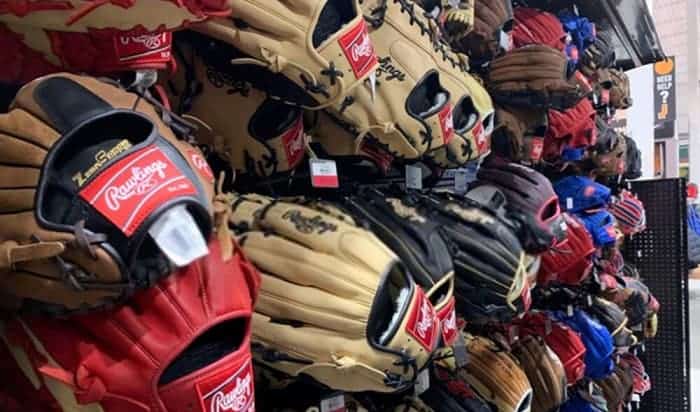A baseball field or ballpark is one of the most spectacular fields in sports. Baseball fields aren’t identical in shape and size.
In this article, you will know how many yards is a baseball field, how big a ballpark is compared to other sports’, and some interesting facts about it.
Contents
Dimensions of a Baseball Field
Baseball stadiums differ in dimensions accounting for the safety of the players and spectators, level of play (e.g., little league baseball or major league), and team strengths.
Nevertheless, here are the general guidelines.
1. Dimensions for the MLB field
- The diamond or ball field is 30 yards (90 feet) between bases.
- Centerfield to the home field is 133.33 yards (400 feet) or more.
- Foul lines measure 320 feet or more.
- The home plate to the nearest fence measures 108.33 yards (325 feet) or more.
- The pitcher’s mound to the home plate is 20.17 yards (60 feet and 6 inches). Its rubber measures 24’’ x 6’’.
- Each base measures 18’ inches on all sides.
- Each base is 90 feet apart from the adjacent base.
- The first base to the third base is 127 feet and 3.357 inches apart.
Here is a typical MLB field.
2. Dimensions for the Little League Baseball (3-4 up to 13-17 age groups):
- The home plate to the pitcher’s mound is 46 feet.
- The home plate to the ballpark fence is from 200-275 feet.
- Each base is 60 feet apart from its adjacent base.
- The outfield fence must be greater than 200 feet but less than 275 feet from the back of the home plate.
Here is a typical LLB field.
Here is a table showing the variations in field sizes by age group.
| Age Group | Baseline
(ft) |
Home to Pitcher’s Mound
(ft) |
Home to Second (Center of Base) | Foul Lines
(minimum distance to fence) (ft) |
Home to Center Field
(ft) |
First Base to Third Base |
| Foal (3-4) | 50 | 38 | 70ft. 8.5in. | 125 | >200 | 70ft. 8.5in. |
| Shetland (5-6) | 50 | 38 | 70ft. 8.5in. | 125 | >200 | 70ft. 8.5in. |
| Pinto (7-8) | 60 | 38 | 84ft., 10in. | 125 | >200 | 84ft., 10in. |
| Mustang (9-10) | 60 | 46 | 84ft., 10in. | 175 | >225 | 84ft., 10in. |
| Bronco (11-12) | 70 | 50 | 99ft. | 225 | >275 | 99ft. |
| Pony (13-14) | 80 | 54 | 113ft., 2in. | 265 | >315 | 113ft., 2in. |
The Evolution of a Baseball Field
There are important key points in the history of the baseball field.
- There have been minor changes in the layout of the field since the Knickerbocker Rules of the 1840s. The design was a diamond-shaped infield.
- The National Association of Baseball Players (NABBP) Convention of 1857 prescribed the 30 yards distance between bases.
- In the 1870s, the distance from the home plate to the pitcher’s “box” was 45 feet.
- The home plate was a circular iron plate from 1857-1867. It had a diameter of approximately 13.5 inches. But it was changed to a square with 12 inches on each side in 1868.
- Before 1874, there were no batter boxes. They measure 6 feet x 3 feet and 12 inches from the home plate but were increased to 6 feet x 4 feet in 1885.
1. The Outfield
Outfields differ in size depending on the overall dimensions of the ballpark and the type of league, whether it’s LLB or MLB. It is the fair territory beyond the infield or the area between the foul lines.
In MLB, the average size of the outfield is 400 inches while in LLB, it’s 200-275 feet.
2. The Infield
The infield is the area within the square formed by the four bases. It measures 30 yards (90 feet) on each side for MLB and 20 yards (60 feet) for LLB.
1. Pitcher’s Mound
The pitcher’s mound measures 18 feet in diameter and 10 inches higher than the home plate. The white rubber on top of it is 6 inches measuring from front to back, and 2 feet when measured across.
The front of it is 60 feet and 6 inches away from the rear of the home plate. The plate slopes downwards six inches from the pitcher’s mound.
2. Home Plate
The home plate is a five-sided slab made of white rubber. One side measures 17 inches long while the two adjacent sides are 8.5 inches each. The two sides are 12 inches each and form a right angle.
3. The Bases
Each base has a length and width of 15 inches with a height of 3-5 inches.
The distance between bases is 90 inches; hence the total base path is 360 inches. The infield area between bases measures 752.5 m2.
4. The Foul Lines
Foul lines are the lines from the home plate and first and third base extending to the nearest fence or stand. Each line is about 320ft. long.
How to Count Yards on Baseball Field
Considering how wide the perimeter of a baseball diamond is, it makes sense to measure it in yards or in feet. There are also references that present baseball dimensions in meters.
Let’s find out how long is a baseball field in yards.
In determining the measurements of a baseball field, there are three things involved:
- Distance between the bases. In high school, college, and MLB, it’s 30 yards, whilst in LLB, it’s 20 yards.
- Distance from the home plate to the outfield fence. In most instances, the distances to the left and right field corners differ, and the outfield fence may not be a straight line. The usual distance from home plate to fence is 100-140 yards.
- Distance from the pitcher’s mound to the home plate. The distance from the front of the pitcher’s rubber to the back point of the home plate is 20.17 yards (60 feet 6 inches).
Comparison of some famous baseball fields
| Left field (ft) | Center field (ft) | Right field (ft) | |
| Fenway stadium | 310 | 389 | 302 |
| Dodgers field | 419 | 450 | 301 |
| Second Washington Park field | 335 | 445 | 215 |
| Yankee field | 318 | 408 | 314 |
Factors That Affect the Dimensions of a Baseball Field
If you are wondering why the length of the baseball fields differs, several factors come into play.
- Level of play: The dimensions of a ballpark differ depending on the level of play, such as LLB or MLB.
- Available space: Some fields have more available space so they have larger dimensions. Those with limited space especially in urbanized areas have smaller dimensions.
- Team preferences: The style of play can influence ballpark dimensions. For instance, if the team has many power hitters, a shorter distance to the outfield fence is preferred. Batters and pitchers may prefer more or less field and may adjust their approach depending on the size of the field.
- Climate, the topology of the surrounding area, and air density: A ballpark in regions with a warmer climate tends to have bigger fields considering that balls travel farther in warmer temperatures.
- Stadium configurations: Some fields are designed to accommodate many fans and provide great amenities for the fan’s comfort and entertainment.
How Baseball Fields Are Maintained
Baseball field maintenance involves three major considerations, such as playability, safety, and aesthetics. These are the general guidelines that maintenance workers often follow.
- Schedule regular mowings to keep the grass in its desired appearance. Water it as needed and keep it at least one-third of its growth.
- Conduct annual soil testing, aerate the soil, and provide nutrients to keep it healthy.
- Grade the infields.
- Regularly rake and drag the field.
- Examine and maintain the field before and after use.
- Perform general maintenance and repairs.
The Importance of Field Dimensions in Baseball
Although baseball dimensions vary considerably, important considerations are accounted for.
- Safety: Field developers consider how baseball configurations can ensure the safety of the players and the spectators. For instance, a pitching mound that is too high can increase the risk of arm injury to the pitcher.
- Strategy: The dimensions of the field can influence the strategic decisions of the teams. For example, a shorter distance to the outfield fence can lead to more home runs.
- Players’ development: The field’s dimension can influence the skills development of the players. A small field may not allow players to enhance their running and throwing techniques.
FAQs
What is the biggest baseball field and how many feet?
The biggest baseball field is the Coors Field in Colorado, which measures 121,486 ft2. It’s also considered as the most hitter-friendly field.
What is the difference between a baseball field and a softball field?
The average baseball field size is greater than that of softball.
In baseball, the distance between the sides is 325 feet while in softball it’s 190 feet. Baseball bases are 30 yards apart whereas softball bases are 20 feet apart.
The distance from the home plate to the centerfield is 300-400 feet in baseball whilst, in softball, it’s 200-220 feet. From the pitcher’s mound to the home plate, it’s 43 feet for softball and 60 feet 6 inches for baseball.
Are high school fields similar to MLB fields?
Yes, they are quite similar. The distances from the home plate to the pitcher’s mound are the same as well as the distances to the outfields.
Conclusions
There is no definitive answer as to how many yards is a baseball field. Ballparks don’t have uniform dimensions due to practical and historical reasons.
However, there are general guidelines that are being followed, especially in a professional baseball field to ensure the fairness of the game and the safety of the players and spectators.
No matter the shape and size of a baseball field, it cannot trump the skills and performance of your favorite players. It may have some impact but the pros are flexible and can take advantage of the field’s dimensions to increase their chances of victory.

A powerful swing and the ball is flying across the field, just one hit, and we might never forget the thrill it brings. I do not know about you, but I never do. Every baseball game is the chance to compete with others and cooperate with your teammate. It is among my biggest passions.



